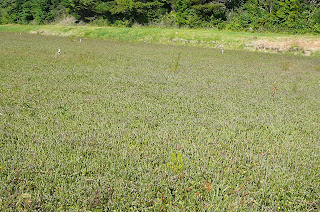I've always been intrigued with cranberry bogs. Anyone who sat in my 5th grade science class over the years knows how I've longed to see one in real life. There is something about all that pink-red color covering the water when the berries are afloat that is just lovely to look at. Then on our way to the beachside town of Bandon, I read that it is the "unofficial" cranberry capital of Oregon. Surprising to note, Oregon contributes a considerable amount to the cranberry crop. Hoping to see firsthand what I'd only seen in pictures, I stopped in at the Bandon tourist office to learn more. The lady there really didn't know anything about the bogs location (don't really understand that as Bandon hosts a big Cranberry Festival every fall). Not be deterred from my hunt for the berry, I did a bog search to locate one. Thanks to my husband's willingness to go along on this backroads trek, we finally found it . It took some doing as the bogs didn't look anything like I had imagined. They were big square pits, no floating beauties, just a mass of greenery. We parked for a close-up view and found the pit was filled with a mass of vines that had berries not fully ripe yet. This piqued my curiosity and led to further investigation.
The cranberry is one of the few fruits that originated in this country. It was first called "crane berry" because someone thought the way the fruit hangs from the vine resembled the look of a crane. Bogs are depressions in the ground that are marshy so you will find cranberry bogs are going to be near water such as wetlands. During growing season the cranberry bogs are drained of their water. When it's time to harvest, the farmer floods the bogs so that the berries float. They do this because they have air pockets in them (remember that pop you hear when you boil the berries to make sauce?). After they loosen from the vines, a big floating boom kind of "rounds up" the berries so they can be removed from the water. And that's the part I'd really love to see. During the growing season, farmers wear stilts to roam around their bogs.
To determine fruit goodness you bounce the berries. The first guy to do this John Webb in 1880, would toss his berries down the steps and the ones that bounced were keepers. As to the beautiful picture of the floating fruit on the Ocean Spray website? Maybe in September.
Subscribe to:
Post Comments (Atom)




No comments:
Post a Comment